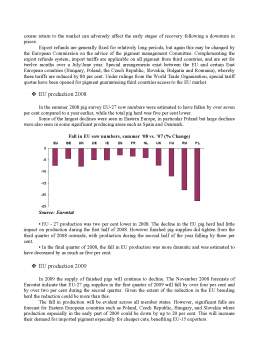Cuprins
- Chapter I. Common Market Organisation of pigmeat in European Union
- 1.1 Act and scope of the Common Market Organisation of pigmeat
- 1.2 The main instruments that regulate the market of pigmeat
- Chapter II. Common Market Organisation of pigmeat in Romania
- 2.1 Romania’s position
- 2.2 Romania’s demands
- 2.3 Overview of the Romania pigmeat sector
- 2.4 Negotiation results
- Chapter III. Conclusions
Extras din proiect
Chapter I
Common Market Organisation of pigmeat in European Union
1.1 Act and scope of the Common Market Organisation of pigmeat
The EU pigmeat sector is subject to a market-organisation regime governed by EU law. The idea is to stabilise the markets and guarantee fair standards of living for farmers in the sector by setting up a price system and regulating trade with non-EU countries.
-Act
Regulation (EEC) No 2759/75 of the Council of 29 October 1975 on the common organisation of the market in pigmeat.
This Regulation sets out the common organisation of the market in pigmeat, comprising the Community classification of the products concerned, the price arrangements and the arrangements for trade with third countries. It also contains general provisions on exceptional market support measures and the Management Committee for Pigmeat.
As of 1 July 2008, products falling within the scope of this Regulation are governed by the common organisation of agricultural markets.
-Scope
The regime covers live pigs (but not pure-bred breeding pigs) and derived products such as meat and processed products.
1.2 The main instruments that regulate the market of pigmeat
-Direct aid
Following the 2003 reform of the common agricultural policy (CAP), pig farmers may receive direct aid and payments not linked to production.
-Price system
This consists of a number of elements that encourage operators in the sector to take measures, either individually or jointly, to ensure that the supply is in line with market demand.
-Basic price
The basic price for a pig carcass is €1 509.39 per tonne. This refers to the "standard" quality (category E) for carcasses of between 60 and 120 kg, and category R for carcasses weighing over 120 kg.
-Intervention
In order to prevent a significant drop in prices, private storage aid and intervention measures make it possible for carcases, half-carcases, belly of pork and fresh or chilled pig fat to be bought in. Where the Community price weighted by a coefficient reflecting the size of the pig herd in each Member State is less than 103% of the basic price, authorisation may be granted for the adoption of intervention measures. The buying-in price for pig carcases of a standard quality is between 78% and 92% of the basic price. The buying-in price for products other than pig carcases or products which are not of a standard quality is calculated on the basis of the price for pig carcases of a standard quality. Public buying-in has not been used for some 20 years.
-Regulating trade with non-EU countries
-Issuing of import and export licences
Imports and exports may be subject to import or export licences.
-Common customs tariff
Pigmeat products are subject to the rates set in the common customs tariff.
-Imports
Where there is a risk that imports could destabilise the Community market, additional import duties can be levied. These extra duties are not currently being levied, however.
-Import tariff quotas
Tariff quotas are attributed on the basis of requests made by operators every three years. They are governed by a system of import licences.
-Lifting of import duties
If at any stage it is judged that the medium-term outlook on the EU market is for prices to rise, import duties may be partially or completely suspended.
-Exports
Export refunds may be granted to assist exporters. To qualify for such refunds, operators must hold an export licence.
-Processing
The inward/outward processing scheme may be suspended.
-Barriers to trade
Taxes that have an equivalent effect as customs duties and the imposition of any quantitative restrictions or similar measures are prohibited in trade with non-EU countries.
-Safeguard measures
Safeguard measures may be taken if there is a risk that imports or exports could disturb the Community market.
-Other provisions
-Animal diseases
Where there is an outbreak of an animal disease and the sector is subjected to any sort of commercial restrictions, the Commission may take emergency measures to support the pigmeat market.
-Government subsidies
Unless the legislation provides otherwise, the pigmeat sector is subject to the Treaty rules on government grants (state aid).
-Communication
The Member States and the Commission are required to provide each other with the information each the needs to implement the legislation.
-Committee procedure
In implementing the legislation, the Commission is assisted by a Management Committee for Pigmeat, consists of representatives from the Member States and chaired by a representative of the Commission.
Preview document
Conținut arhivă zip
- Common Market - Organisation of Pigmeat.doc

























